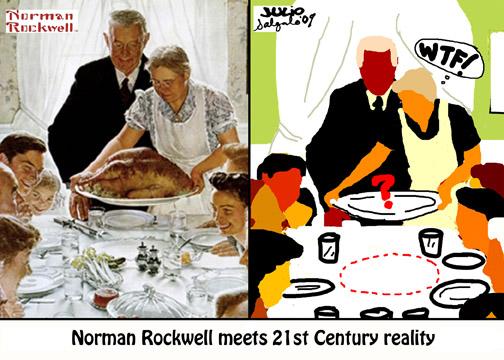One of the topics that rarely reach the American public is expanding hunger within our structures. The ugly phrase “very low food security” has surfaced in our government’s lexicon that should send off red flags, but is likely so disturbing, we don’t want to acknowledge its existence.
Perhaps starving children in our own country is embarrassing enough for us to create ungainly bureaucratic terminology to make it invisible while we’re shopping for that perfect Thanksgiving bird. If hunger isn’t in our faces, it must not exist — at least not in America. Hunger is certainly not something one sees in Norman Rockwell paintings.
“Food insecurity” is the politically correct term used by the U.S Department of Agriculture because the agency doesn’t use the word “hunger.”
Realistically, the term “food insecurity” emanated from the 1980’s Reagan administration, when then-President Ronald Reagan boasted there was “no hunger in America.” Maybe there wasn’t any hunger in the White House or even the middle class, but that false claim has led to nearly 30 years of stagnation in conquering domestic hunger.
The truth is that hunger exists on a massive level in the U.S. The USDA reported on Monday that U.S. households lacking consistent access to adequate food skyrocketed to 49 million last year.
Ready access to food is predominately a women and children’s poverty issue. Those who have the most difficulty are single women with children, according to government analysts. The USDA report states that 37 percent of unmarried women raising children skip meals, cut portions or “otherwise forego food,” but let’s not call it “hunger.”
Hunger also is a sociological problem. According to the USDA, about 29 percent of Latino and 27 percent of black households, respectively, suffer “food insecurity” while around 12 percent of white households, mostly in the South, West and Midwest, suffer the same phenomenon.
The shocking estimate is a hunger increase felt by 13 million more Americans since 1995, when the USDA started tracking “food insecurity.”
The USDA reported its food stamp rolls have risen to 36 million, an increase of almost 40 percent during the past two years. During the same period, unemployment at the national level has risen from 4.9 percent to its current 10.2 percent. Because unemployment was at about 7.2 percent when the USDA conducted the “food insecurity” survey, the 49 million families is probably a low estimate.
We’ve been locked into two wars with no seeming end. Projections by U.N. and U.S. economists are that the cost of the wars in Iraq and Afghanistan will exceed $3 trillion or more in the long run. Nearly $1 trillion has been spent bailing out Wall Street, auto manufacturers and the banking industry.
College students are typically givers when they see a social need. Cal State Long Beach has been a sleep burgh this Thanksgiving, with only one visible food drive on campus.
The Health Science Student Association spearheaded a weeklong canned food drive that ends today at 1:30 p.m. Donations of non-perishable food donations can be taken to the Maxson Center on the third floor of the University Student Union and to the Health Science Department in HHS-2. As well-intentioned and appreciated as these student efforts are, they amount to a drop in the gravy boat.
College campuses can’t be expected to solve what has amounted to a food crisis. They can make a dent, but the real solutions need to be treated as a national security issue. That’s right, “food security” should be deemed a national security issue.
It’s time we reset our national moral compass and focus on feeding those who need adequate food — those we likely see everyday.




